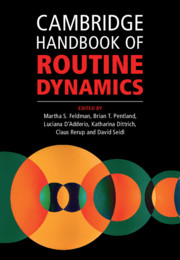Book contents
- Cambridge Handbook of Routine Dynamics
- Cambridge Handbook of Routine Dynamics
- Copyright page
- Contents
- Figures
- Tables
- Contributors
- Preface
- Chapter 1 What Is Routine Dynamics?
- Part I Theoretical Resources for Routine Dynamics Research
- Part II Methodological Issues in Routine Dynamics Research
- Part III Themes in Routine Dynamics Research
- Part IV Related Communities of Thought
- Chapter 33 Carnegie School Experiential Learning and Routine Dynamics
- Chapter 34 Dynamic Capabilities and Routine Dynamics
- Chapter 35 Strategy as Practice and Routine Dynamics
- Chapter 36 Path Dependence and Routine Dynamics
- Chapter 37 Business Process Management and Routine Dynamics
- Author Index
- Subject Index
- References
Chapter 35 - Strategy as Practice and Routine Dynamics
from Part IV - Related Communities of Thought
Published online by Cambridge University Press: 11 December 2021
- Cambridge Handbook of Routine Dynamics
- Cambridge Handbook of Routine Dynamics
- Copyright page
- Contents
- Figures
- Tables
- Contributors
- Preface
- Chapter 1 What Is Routine Dynamics?
- Part I Theoretical Resources for Routine Dynamics Research
- Part II Methodological Issues in Routine Dynamics Research
- Part III Themes in Routine Dynamics Research
- Part IV Related Communities of Thought
- Chapter 33 Carnegie School Experiential Learning and Routine Dynamics
- Chapter 34 Dynamic Capabilities and Routine Dynamics
- Chapter 35 Strategy as Practice and Routine Dynamics
- Chapter 36 Path Dependence and Routine Dynamics
- Chapter 37 Business Process Management and Routine Dynamics
- Author Index
- Subject Index
- References
Summary
In this chapter, we compare Routine Dynamics and Strategy as Practice based on an extended literature review. Routine Dynamics and Strategy as Practice are distinctive communities of thought in organization studies that exhibit a number of striking parallels: both subscribe to the overall “practice turn” in the social sciences, seek to bring the human being back in, and focus predominantly on the level of action involved in organizational routines and strategy, respectively. In our comparison of similarities and differences of Routine Dynamics and Strategy as Practice, we focus on their empirical domains, underlying theoretical perspectives, research frameworks, levels of analysis, and empirical methods employed. Based on that, we discuss what Routine Dynamics can learn from Strategy as Practice and vice versa. We conclude with some general reflections on the future relation between the two research communities and develop an agenda for future research that facilitates cross-fertilizations between the two research communities.
Keywords
- Type
- Chapter
- Information
- Cambridge Handbook of Routine Dynamics , pp. 481 - 500Publisher: Cambridge University PressPrint publication year: 2021
References
- 2
- Cited by



